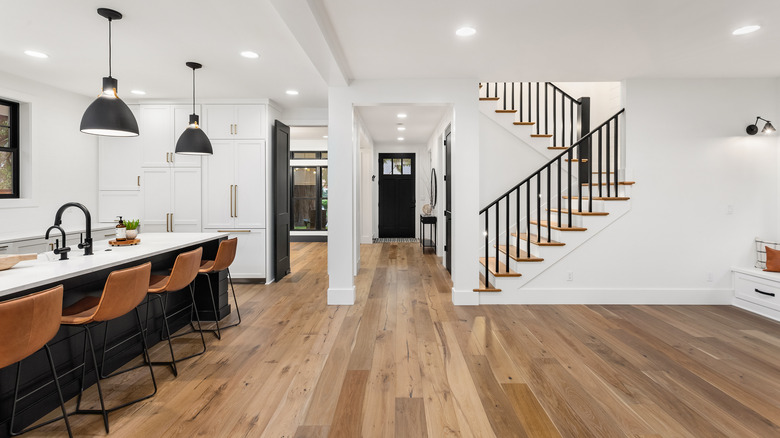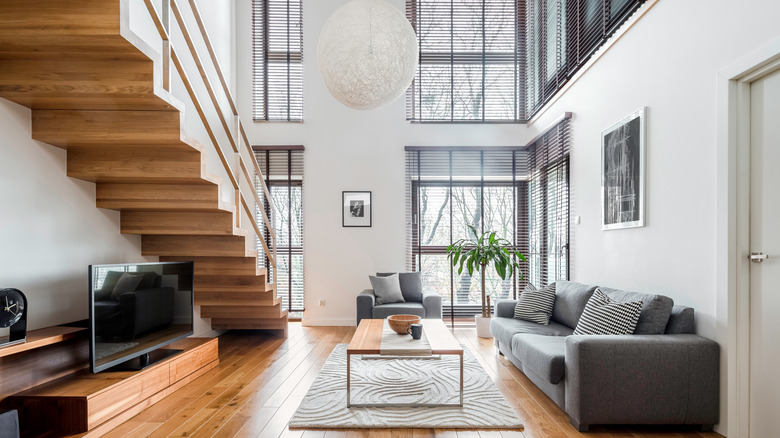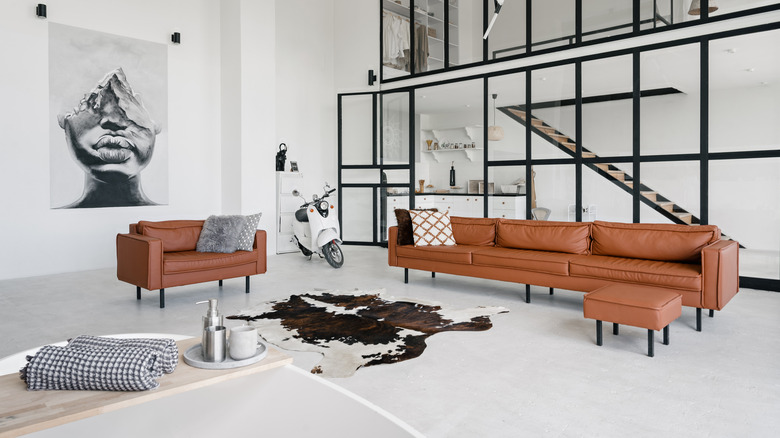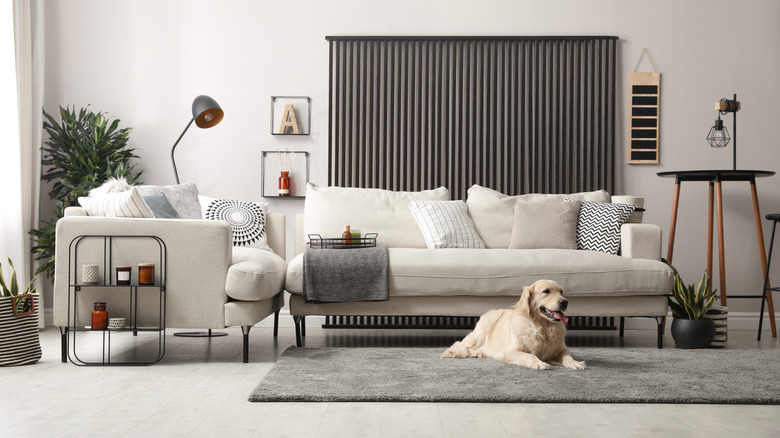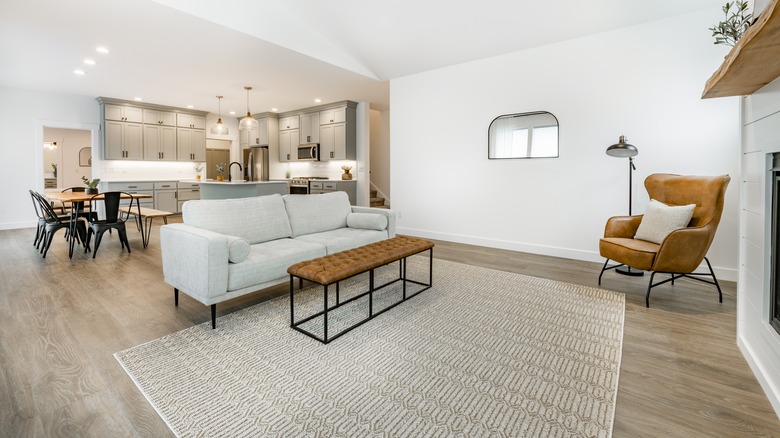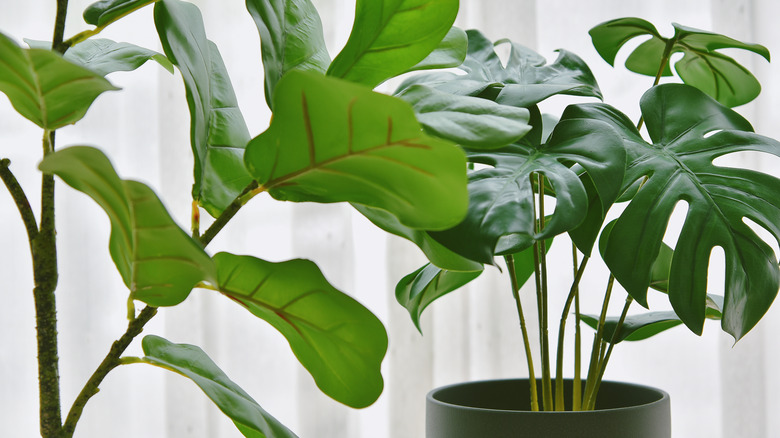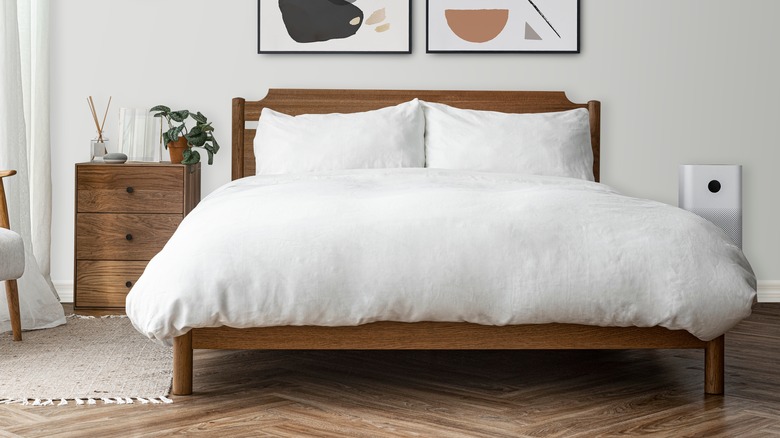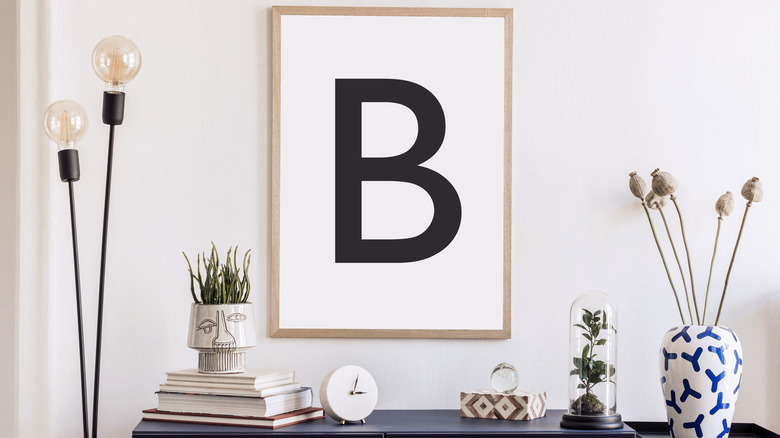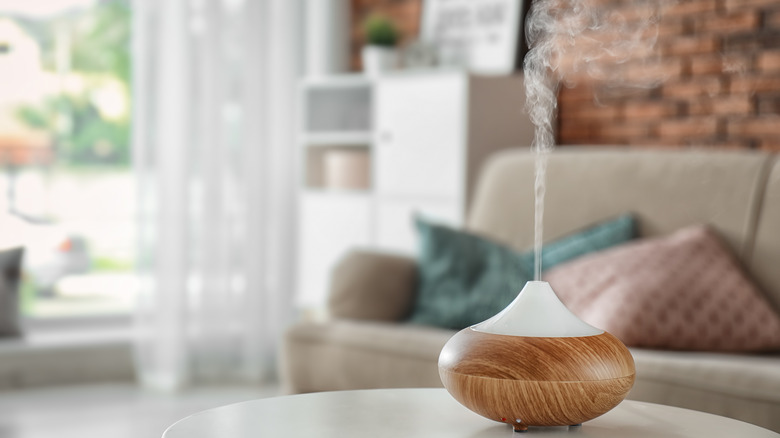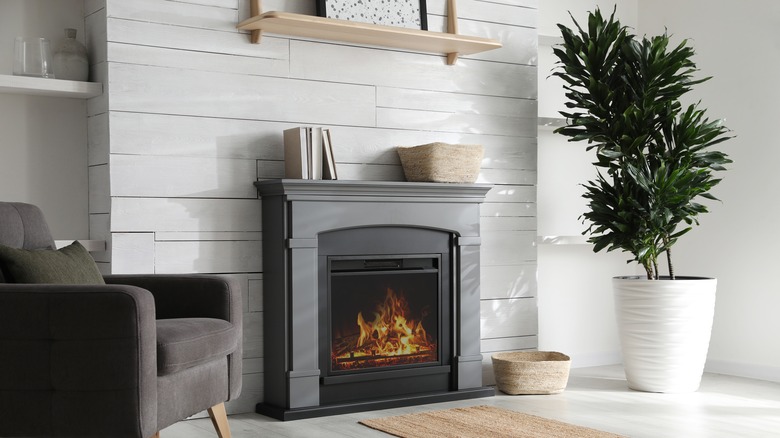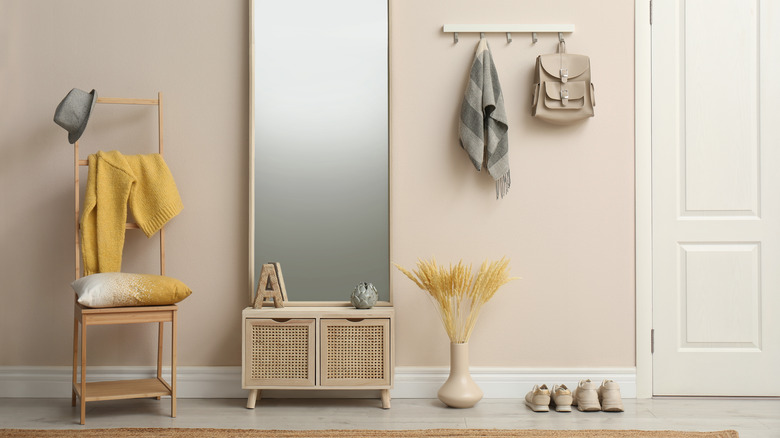Stylish Ways To Reduce Allergens In Your Home
Feeling miserable in your own home can be incredibly frustrating. However, if you suffer from indoor allergies, several factors may contribute to your stuffiness and endless sneezing. According to The American Academy of Allergy, Asthma, and Immunology, millions of people experience allergy symptoms year-round from irritants like dust mites, pet dander, and mold particles wreaking havoc on their immune systems.
Of course, you can use all the nasal sprays and antihistamines on the market to relieve your symptoms while you're at home. However, reducing the allergens in your home can be the most effective way to feel better. You don't need to turn your home into a sterile and boring environment. There are some super stylish ways to reduce allergens in your home while making it stunning, welcoming, and filled with unique character. From major overhauls to small decor swaps, you can create a happy, allergy-friendly home where you feel best your best.
Switch out carpeted floors for seamless hard flooring
According to the Environmental Protection Agency, carpeted floors trap dust, debris, and pollen particles. More than likely, your carpet is causing allergy attacks. These build up exponentially over time, and any moisture under the carpet can eventually cause mold. Properly cleaning and maintaining carpeted areas to prevent these issues can be time-consuming and unsustainable for many homeowners. Consider swapping your carpet for hardwood floors to create a more allergy-friendly home.
Hard flooring surfaces have their own unique set of benefits. The biggest, however, for allergy sufferers is the ease of cleanliness. You can quickly and easily clean them with a vacuum and mop combination tool designed to get them as clean as possible (via Readers Digest). Not only does the vacuum function suck up dirt and debris, but the mop function also essentially rinses away any remaining pollen or dust. Going with hardwood can also add tons of style to your home. There's also an option to complement every decor style out there (via HomeAdvisor). Hand-scraped planks add stunning detail to farmhouse-styled homes, while cherry hardwood looks great in homes with traditional decor.
You can also opt for one of the wood-look flooring surfaces on the market. Laminate flooring can be an economical choice that's easier to install (via HomeAdvisor). Vinyl flooring emulates wood or stone at a fraction of the price. Or, if you are craving the softness and quietness of carpet, try cork floors. No matter what floor you choose, it can be wise to use it throughout your home, especially for allergy sufferers. A seamless flooring design improves the flow between rooms and makes your spaces feel cohesive (via Weekend Builds). It also creates an airy feel that can make your home look more spacious. Plus, having the same surface throughout your home means you can use one tool to clean it all properly and reduce allergens quickly and easily.
Replace curtains with dustable and stylish window treatments
As Mr. Timesaver points out, curtains attract and trap dust and allergens, especially if they are made of thicker materials or have multiple layers. Cleaning your curtains can be a tedious task that many homeowners overlook. Plus, many curtains have fabrics that require costly professional dry cleaning. Instead, use easy-to-clean window treatments that you can thoroughly clean.
Blinds are an option available in an endless array of styles and colors. Faux wood blinds can add warmth and character to your home, while panel blinds have a modern look. You can also opt for micro blinds, a thinner, less expensive take on Venetian blinds that are perfect for narrow windows or small spaces (via Angi). Another option that works with many styles is roller shades. These come in many colors and sizes that you can seamlessly integrate into your decor. Interior designer Jenny J. Norris tells The Strategist, "An overtreated window can feel dated. For a more understated window, go for a solid color roller shade."
When selecting your allergy-friendly window treatments, you might opt for the same look in every room of your home. Or, you might want to mix it up a bit according to the needs of each space. The most important thing is to keep curb appeal in mind (via Hunter Douglas). Look at your home from the outside with the window treatment closed, both during the day and at night. They should create a cohesive look that doesn't distract from the home's exterior design.
Rethink furniture material and shape choices
Your upholstered furniture might be comfy and cozy. However, it's a likely haven for allergens to hide deep within the cushions. Allergist Bruce Pfuetze tells the Chicago Tribune, "Upholstery is also an ideal environment for mold." He adds, "An area of a couch where a pet likes to sit can have such high concentrations of pet dander that sensitive patients will have more of a reaction to the couch than if they buried their face in the animal's fur." This build-up of irritating dander and mold might prompt you to rethink your upholstered furniture. Plus, these pieces can be tedious to vacuum and impossible to clean. Steam cleaning can damage upholstery, and professional cleaning is a costly option. Instead, look for items in low-maintenance, super cleanable materials that still look great.
Leather furniture is one of the best options to clean (via Unichairs). You can simply wipe it down with a cloth to remove dust or allergens. Plus, you can choose an option that looks awesome with your current decor. A low-slung tufted loveseat can look perfect in a mid-century space, while a sleek leather sofa adds style to an industrial interior.
For a more economical option, check out vinyl options. The design can emulate leather while still being low maintenance and easy to clean. Plus, it comes in countless colors. You can go with a bold hue to make a stunning statement. However, cleaning your couch isn't enough to rid your living space of allergens. Frequently vacuuming under your couch is a must for keeping dust bunnies at bay. Look for elevated couch options that sit atop stylish legs (via One Good Thing by Jillee). Not only does this add refined character, but it also makes cleaning under the couch a cinch!
Make allergy-friendly throw pillow choices
Textiles are a big part of creating character and dimension in your home. However, these cozy details can be a harbor for irritating allergens. Laurie Blevins Fowler, an allergy clinic director, told the Chicago Tribune, "Microscopic mites and pet dander can take up residence in decorative pillows and throws as well, especially feather pillows."
Opt for washable and allergy-friendly options if you're craving the softness that throw pillows add to your furniture. Look for throw pillow covers in materials that can be easily machine-washed to remove allergens (via Deconovo). Check out fabrics like polyester and cotton that come in multiple colors and patterns to fit your design aesthetic. Linen pillows in subtle shades can add a natural look, while silk pillows give your room a glamorous sheen. Double-check the care instructions before buying to ensure they're okay to toss in the machine.
When selecting throw pillow inserts, look for a high-quality down alternative. These feature cotton or polyester fibers instead of the typical allergy-inducing feathers (via Sleep Foundation). They are also often machine washable and come at a lower price than down pillow options — a win, win!
Look for stylish, washable rugs
Strategically placed rugs ground your spaces and inject instant style into your rooms. However, like carpets, they can trap irritating particles. Luckily, plenty of quality washable options are available in any color and style you can imagine. Look for coordinating choices for every room in your home, including kitchen runners and expansive area rugs. Make sure you can put them into your home washing machine for thorough cleaning. Melanie Carver, from the Asthma and Allergy Foundation of America, told NBC News, "The carpet fibers and the pad under the carpet can trap and hold particles like dust as well as allergens like dust mites, pet dander, pest debris, and mold spores — when you vacuum or otherwise 'disturb the carpet,' it can cause these irritants and allergens to become airborne as well."
Another option to keep in mind is using outdoor rugs in your indoor spaces. These are typically lower in price and come in endless colors, patterns, and designs (via Ballard Designs). They're lightweight and low pile, making them easier to vacuum thoroughly. Plus, they can withstand the elements, and their durability is unbeatable. When they need a good cleaning, simply hang them up outside, scrub any stains with soap, and hose them down.
Swap out real plants for faux choices
Houseplants add character and bridge your home's decor to the outdoors. However, these natural design elements can mean trouble if you suffer from allergies. According to Clarityn, flowering plants can release pollen and trigger a reaction. However, even non-flowering plants can cause issues. Mold is a common allergy, and spores live within houseplant container soil.
Instead, opt for faux plants that still give you a natural look. High-quality faux greenery can look super realistic. Look for options with details like faux soil and textured stems. A tall fiddle-leaf fig tree can add height to your decor, and a faux bird of paradise can create a tropical feel. Options like ferns and boxwood add character to traditional spaces, while eucalyptus stems are perfect with farmhouse decor.
Plus, faux foliage is low maintenance, and you don't have to worry about sunlight, fertilizing, and a tedious watering schedule. However, you'll need to clean it regularly to prevent a dusty build-up. Simply take your greenery outdoors and gently shake it to remove dust (via House of Hipsters). You can wipe off larger-leafed plants with a microfiber cloth or duster. You can even purchase a spray specially formulated to remove dust and debris from faux plants for a low-fuss yet thorough clean.
Allergy-proof your bed
You likely spend a decent amount of time in your bed. Make sure you get a better night's sleep by making it as allergy-friendly as possible without sacrificing comfort and style. It just involves some savvy shopping and allergen-reducing solutions. Sleep Foundation points out that your mattress can be the optimal environment for dust mites, pet dander, and mold spores to thrive. These can aggravate your allergies and make it difficult to sleep. Look for hypoallergenic mattress options for nighttime symptom relief. Many include special allergen covers or barriers for additional protection.
Then, top your hypoallergenic mattress with stylish bedding with hypoallergenic properties (via Rolling Stone). Organic cotton, microfiber, and silk bed linens provide the best protection. Luckily, these fabrics feature many color options to complement your bedroom decor. Top your sheets with a down alternative comforter in a statement-making pattern to make your bedding pop. Make sure to launder your bed linens in hot water once a week to wash away allergens.
To complete your look, add an allergy-friendly headboard and bed frame. Avoid upholstered headboard options that can be tough to clean (via Radtke Appliance). Instead, opt for a stylish wood or metal option that you can easily wipe down. You can also consider adding risers to your bed frame to lift it higher from the floor. Not only does this give your room a posh, sophisticated look, but it also makes it easier to vacuum under the bed.
Declutter and design for easier cleaning
Decluttering can help make your home feel more orderly and organized. It can make it much easier to keep clean as well. You can make some wise design choices that still look awesome and add character while helping reduce irritating dust. One Good Thing by Jillee recommends using glass front shelves to display items like photos and knick-knacks to put your decor on full display while keeping dust out. Add lights to illuminate your shelves and create a custom look.
You can also apply homemade dust repelling spray to decorative accents and surfaces (via The Sun). This easy mixture features olive oil, dish soap, vinegar, and essential oil. Simply spray a thin coat on items to keep dust from building up. When selecting decorative items for shelf styling and other surfaces, look for easy-to-clean materials like metal and glass. It's also good to avoid intricate designs with hard-to-clean nooks and crannies for the dust to hide. Items like metal orbs, ceramic vases, and glass globes make an impact and are simple to clean.
Another hot spot for dust is the tops of hanging art and photo frames. These can be tedious and time-consuming to keep clean. Instead of a gallery wall of small frames, opt for a large statement piece for the same effect. You'll still fill your wall with style but will simplify your cleaning and have just one piece to keep dust-free.
Clean and deodorize your air in style
Airborne allergens can be impossible to eliminate completely. However, you can better manage them with an air purifier. HouseFresh recommends choosing an air purifier that's not only functional but stylish too. Look for a quiet one with a HEPA filter and the right size for your space. Air purifiers with changeable, colorful filters can add a bright pop to your decor. There are even wall-mountable units with mood lights and design plates to turn your purifier into a piece of art.
Air purifiers let you scent your space while reaping some allergy symptom-decreasing benefits (via Healthline). Fill your air with all-natural essential oils using a stylish diffuser that appeals to multiple senses. Opt for choices that reduce allergy symptoms and enhance the feel of your rooms. Lavender adds a soothing vibe to bedrooms and bathrooms, while lemon creates a cheery sense in the kitchen. You can also use peppermint oil to fill your home with festive cheer during the holidays.
Modernize your fireplace
Wood burning fireplaces might be quaint and charming. However, as HuffPost reports, they can release irritating pollutants into the air and exacerbate allergy symptoms. Firewood can also contain mold spores. Even that stack of freshly chopped logs next to the fire can irritate mold allergies without even being burned.
If you are looking for a simple way to reduce allergens while retaining the cozy vibe, fill your fireplace with other sources of welcoming character. Unscented pillar candles of various heights can still give you real flames without the pollutants. You could even go with LED, remote-controlled candles for a low-maintenance option. Or, as interior designer Cathy Maready told MyDomaine, "We also use small containers that burn rubbing alcohol and negate the soot of candles, but still provide that wonderful warmth of a fire."
If you really love the look of a crackling fire, consider switching to an electric fireplace option. These still provide the same ambiance and welcoming vibe to your space. Electric fireplaces are low-maintenance, customizable to your room's layout, and don't have the pollutants caused by burning wood (via Fireplaces Direct). Plus, they come in varying styles to help you find the perfect one for your decor.
Reduce allergens that enter by foot
As Medium points out, outdoor allergens can make their way into your home via the bottoms of shoes. These then settle on your floors and carpeted areas and compound over time. The result can be a build-up of pollen and other outdoor allergens that make you feel worse inside your home. Stop these pesky particles from hitching a ride with stylish entryway ideas.
Ideally, you can adopt a no-shoe policy within your home. This step is simple with family members but can be awkward with guests. Style your entryway to make the no-shoe policy easy and convenient. First, communicate your rule with a cute sign that's more quirky than offensive. A simple chalkboard with the quote "please take off your shoes and stay a while" or a framed printout simply saying "shoes off please" in a cute font should be all you need (via Diana Elizabeth).
Etiquette expert Liz Bryant told Martha Stewart, "Make sure you have a place near the front door where guests may sit to change their footwear." Maybe add a cute bench or stylish side chair to give guests a convenient place to store shoes. A few cubbies or a dedicated shelf in an entryway closet can do the trick. You can also keep a supply of low-cost, single-use slippers near your entryway for a welcoming touch. In order to make your home's entry points a barrier to outdoor pollutants, add doormats to each one (via Chicago Tribune). These allow residents and guests to wipe pollen and debris from their shoes before entering the door. Plus, there are many great options to add style to your home. Customizable options like monograms, ones with humorous quotes, and mats in colorful patterns add character to your entryways while reducing allergens.

